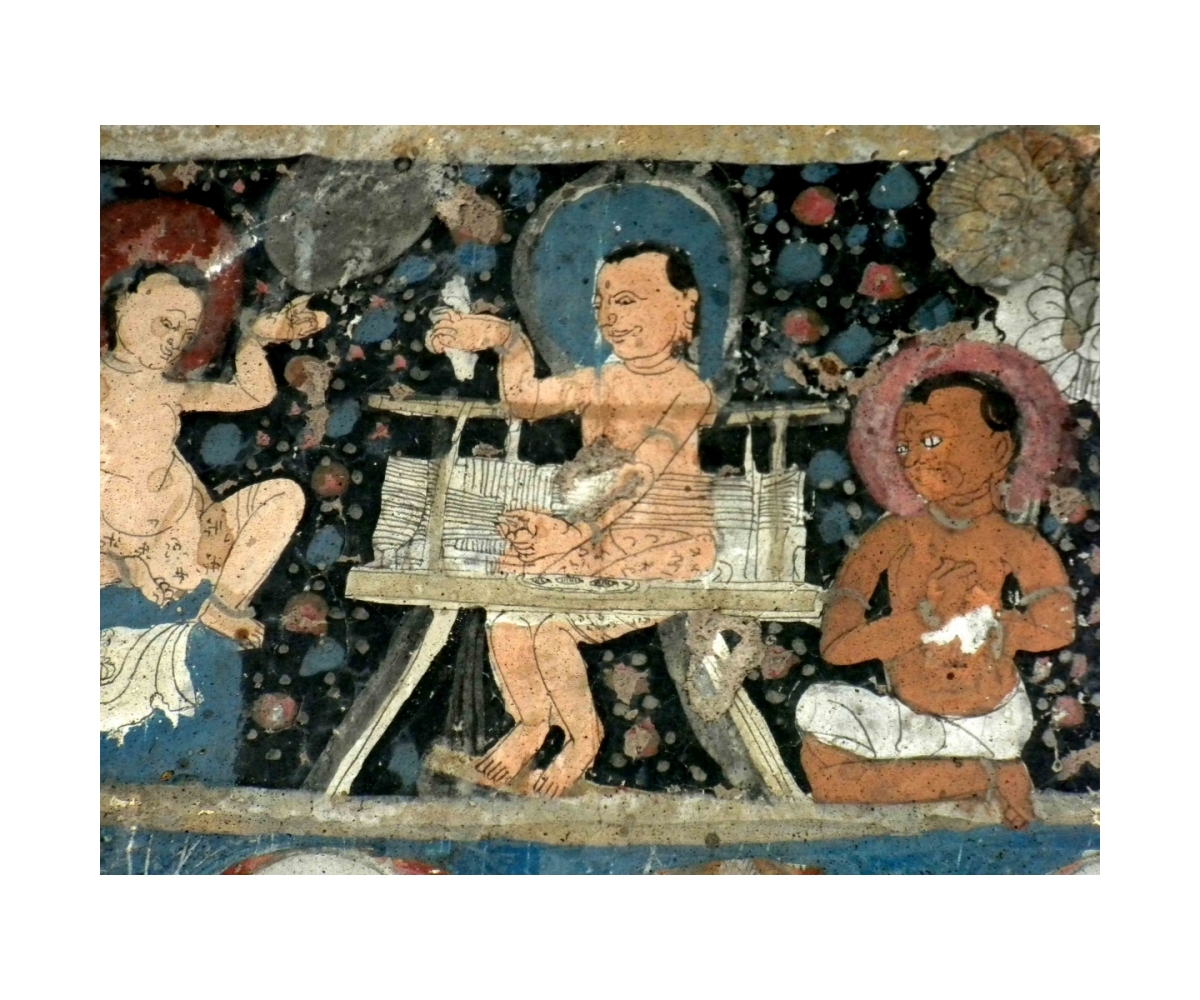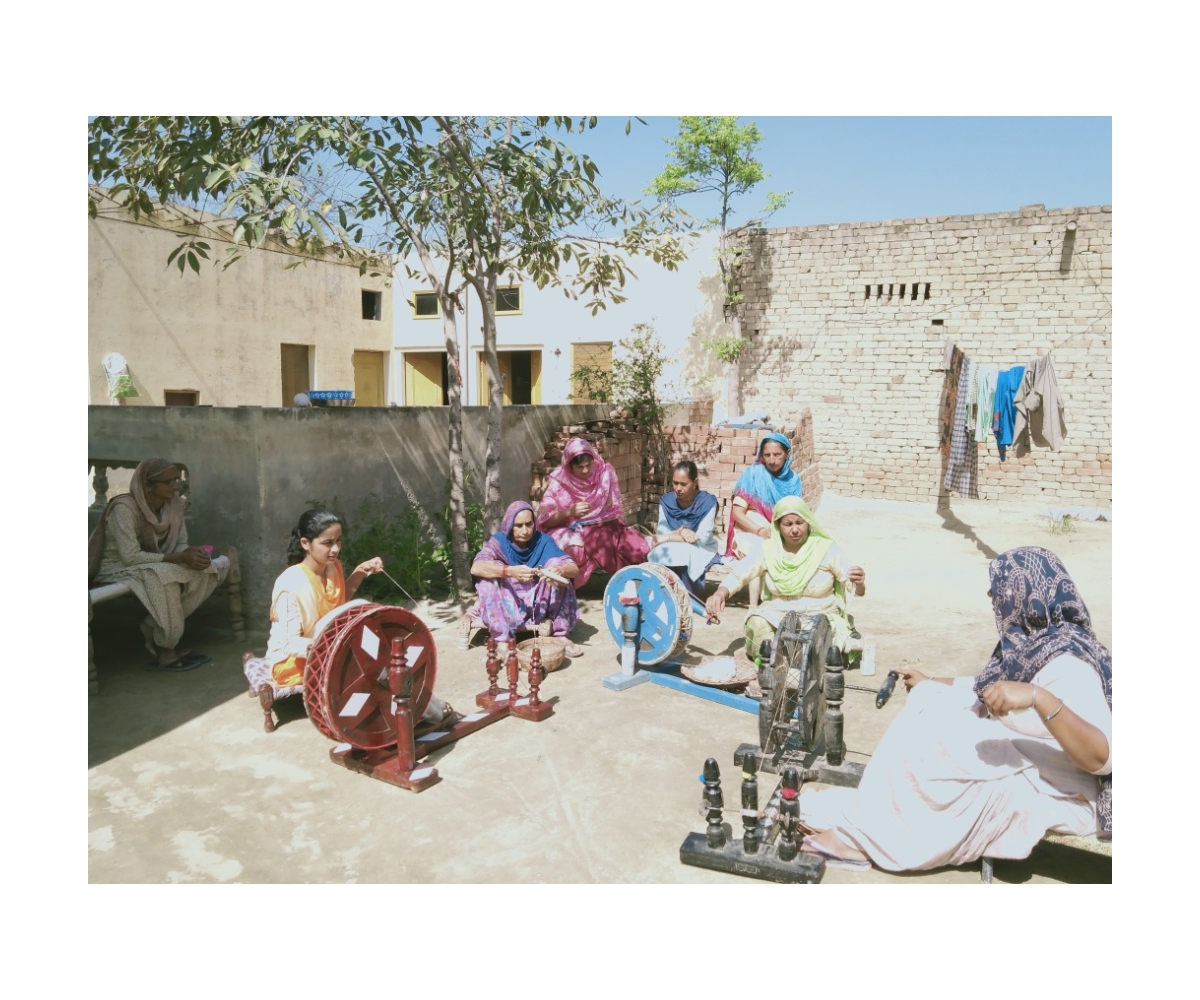PERSPECTIVES
Textile Soundscapes: Weaving Song, Work and Memory
The woman who is parted from her lover spins at the spinning wheel.
The city of the body arises in its beauty;
and within it the palace of the mind has been built.
The wheel of love revolves in the sky,
and the seat is made of the jewels of knowledge:
“What subtle threads the woman weaves,
and makes them fine with love and reverence!”
Kabir says: “I am weaving the garland of day and night.
When my Lover comes and touches me with His feet,
I shall offer Him my tears.”
— Kabir
In the rhythmic clacking of the loom and the repetitive movement of the shuttle, there is a meditative quality akin to the fingering of prayer beads. Kabir, the author of these verses, was a fifteenth-century Indian mystic, saint and social reformer known for his devotional poetry, sung as bhajans or devotional hymns to this day. Whether by likening the colours of a sunset to a piece of dyed yarn woven into the fabric of the sky, or extolling human skin as the Maker’s finest ‘weave,’ it is not entirely surprising that his poetry makes references to the act of weaving. After all, Kabir was a weaver by profession, and it is possible that he composed these verses while weaving at his loom, passing baana (weft) over taana (warp), and then under again, to weave cloth.
Textile-based techniques and practices are typically associated with the senses of sight and touch, however when we discover how they find seamless mention in verses that are recited or sung we realise that they can just as easily be linked with hearing and sound.
Meaning, Metaphor and Textiles
Metaphors that centre around the textile practices abound in present-day India and Pakistan. For example, performance traditions across India — including Nautanki, Bhavai, Jatra, Bhand Pather and Therukoothu, amongst others — have a central character known as “sutradhar” meaning “thread holder”, who narrates and holds the various “threads” of a theatrical play. Popular and folk song and poetry in both India and Pakistan often reference warp and weft, taana and baana, and the spinning wheel or charkha, in the context of either love or spirituality, often combining both, as we see in the songs O Re Piya (Aaja Nachle, 2007), Charkha Nolakha (Atif Aslam & Qayas, 2012), Charkha (with iterations sung by Ustad Rahat Fateh Ali Khan, the Wadali Brothers, and others), Charkha Mera Rangla (Sung by Chitra and Jagjit Singh, the Wadali Brothers, and others) and Rabba Mere Haal Da (Abida Parveen, in Hazrat Shah Hussain, 2002), to name a few.
In the mountainous region of Ladakh, for instance, the loom and the very act of weaving assume metaphorical significance in songs — whose singers are typically weavers themselves. Monisha Ahmed, an art historian specialising in Ladakhi textiles, has written about how the loom and life are intrinsically bound in the region. According to local legends, the practice of weaving in Ladakh was derived from the magical loom of Duguma, the wife of the mythical Buddhist King Gesar of Ling. Myths abound about Duguma working at her loom, weaving one row a year until the day her weave is complete, signalling the end of the world. It is noteworthy that the magical loom of Duguma appears to be a backstrap loom, the kind used by the women of Ladakh.
See the loom as precious,
That is good.
See the loom as a monk’s shrine room,
See the loom as the main shrine room in a monastery,
And you will grow.
See the square mat you sit on while weaving, as a meditation cushion,
That is good.
See the back-strap, which holds the loom around your back, as the casting of samsara behind you,
See the balls of weft passing from right to left as the monk’s kettle that serves tea up and down the monastery hall,
Hear the clap of the beater as the voice of Buddha reciting prayers,
That is good.
See the two wooden pieces of the front roller as the wooden covers of a religious book,
See the raising of the heddle while weaving as ascending in this world after death,
See the lowering of the heddle while weaving as pushing all sin down with your feet,
See the warp, which is soft and long, as the path to liberation,
And you will grow,
That is good.
As the verses of these songs reveal, like in the example above, the various elements that make up the experience of sitting at a backstrap loom to weave, become metaphors for aspects of Buddhist philosophy and practice. In essence, the act of weaving itself is equated with a religio-spiritual experience that allows the weaver to move towards liberation.
The relationship between songs and weaving in India goes beyond lyric and metaphor alone, the two together also have a unique place in communal practices.
Co-Working: Song, Labour and Identity
Often in the case of community-based practices that involve a number of individuals working together, or participating in an intergenerational tradition, practitioners sing in camaraderie to accompany their work. Their songs reflect their intimate lives and cultures, often integrating references to their textile-based work within them.
Traditionally, in the villages of present-day Punjab and Haryana for example, groups of women gathered together in open courtyards under the afternoon sun. With their husbands away at work on farms, they spun cotton together, all the while chatting and singing songs to keep pace with the rhythmic whirring of their spinning wheels.
This act of spinning, weaving and singing together was called trinjan, and featured regularly in rural domestic spaces. Many trinjans included songs expressing the longing, nostalgia and hopes associated with the women’s lost girlhood. Others songs used metaphors and literary allusions to imbue life into the very act of spinning. For instance, in one song, the singer likens the thread she spins to the physical embodiment of her sorrow —
“Listen O sun, Listen O moon,
Tears roll down my eyes,
The world around me laughs, you see,
As I spin my strands of sorrow.”
In another song, Charkha Channan Da, the singer sings of her mother gifting her a spinning wheel to mark her wedding, which she then uses to spin cotton to clothe her beloved. Traditionally these songs were also sung for brides at weddings, underscoring the deep association textile-based practices had with womanhood. Possessing the skills of spinning, weaving and embroidery was seen as an asset and a source of pride for the bride — a mark of ideal femininity. These skills were considered women’s work in the region and the tasks and gatherings associated with them were a gendered form of building community.
But as the women gathered together during trinjans, they not only transmitted the generational knowledge of such work to younger women, but also exchanged stories, teased each other and created a space where they could express themselves through these songs. While the gatherings have died out today — as younger generations cease to engage in these activities — the songs continue to live on in the region; circulating even today in folk albums which collate trinjan songs.
In other parts of India, where textile practitioners work with multi-step processes to create fabric, songs are used as mnemonic devices and serve as aural instructions.
Keeping Count: Rhythm, Instruction and Memory
In his study exploring the connections among Indo-European textiles and metrical poetry, scholar Anthony Tuck documents weavers’ practices of using count sequences that chart out the required number of knots and warp-weft passes to make particular motifs. These count sequences are committed to memory as songs and transmitted generationally, ensuring that motifs, designs and patterns remain consistent over the years. Especially in carpet and rug weaving traditions, song and chants serve as verbal notations of textile designs, becoming an intrinsic part of the weaving process itself. These songs are repositories of knowledge and at the same time, they aid the preservation of traditional imagery and design.
One such instructional chant is the Talim, — used in the Kashmir region — which is an encrypted code that details how a carpet should be woven. The design of a carpet is first drawn on graph paper, then encoded through symbols that signify the number of required knots and their colour. These symbols are then written on scrolls of paper.
As described by the scholar Gagan Deep Kaur, in settings with multiple weavers, there is usually a reader-weaver who interprets the code verbally, while listener-weavers carry out the instructions on their looms. The reading of the code takes on the rhythm of a chant, and the actions described are carried out by the listener-weavers at the same speed at which the talim is read out, enacting a process that is mesmerising to watch. Voice, instruction, body and thread come together in a seamless process of creation.
Over time, references to textile-based practices have seeped into popular culture and everyday parlance. For instance,the phrase taana-baana, meaning warp-weft, continues to be used in songs and poetry to imply balance or harmony.
An especially enduring and popular motif is the charkha, which is not simply a poetic metaphor used in folk songs. It became a symbol of political resistance in the context of the Indian Independence movements spearheaded by Gandhi. The spinning wheel is emblematic of the Swadeshi movement, which connoted self-reliance and a vision of India’s independence from British economic policies. The 1996 song Chappa Chappa Charkha Chale from Hindi cinema seizes upon the ever-whirring motion of a spinning wheel to imply progress and a revolutionary change that is yet to come.
While this history of weaving sounds and songs lives on in the everyday as metaphors, the material conditions sustaining these practices face challenges. As these folkways fade with time, the preservation of the almost primaeval relationship between voices and weaving has become difficult. However, initiatives such as the TRINJAN project by Kheti Virasat Mission and extensive field recording undertaken by People’s Archive of Rural India (PARI) are efforts to document these invaluable histories of textile, sound, labour and memory, from across India – especially in areas and among communities that tend to be neglected – and preserve them for posterity.
Bibliography
Maskiell, Michelle. “Embroidering the Past: Phulkari Textiles and Gendered Work as ‘Tradition’ and ‘Heritage’ in Colonial and Contemporary Punjab.” The Journal of Asian Studies 58, no. 2 (1999): 361–88. https://doi.org/10.2307/2659401.
Tuck, Anthony. “Singing the Rug: Patterned Textiles and the Origins of Indo-European Metrical Poetry.” American Journal of Archaeology 110, no. 4 (2006): 539–50. http://www.jstor.org/stable/40025056.
Tuck, Anthony. “Stories at the Loom: Patterned Textiles and the Recitation of Myth in Euripides.” Arethusa 42, no. 2 (2009): 151–59. http://www.jstor.org/stable/44578302.
Ahmed, Monisha. The Fabric of Life: Nomadic Textiles from the Ladakh Himalayas | Sahapedia. (n.d.). Sahapedia. https://www.sahapedia.org/the-fabric-of-life-nomadic-textiles-the-ladakh-himalayas
Ahmed, Monisha. “Textile Arts of Ladakh: Nomadic Weaves to Silk Brocades.” Marg Magazine (2002): 68–77
Encyclopaedia of Indian Literature: Devraj to Jyoti. India: Sahitya Akademi, 1988. https://journals.sagepub.com/doi/abs/10.1177/1359183519862585
Kabir, Tagore, Rabindranath and Underhill, Evelyn. One hundred poems of Kabir / translated by Rabindranath Tagore; assisted by Evelyn Underhill. United Kingdom: Macmillan & Company, 1915.





